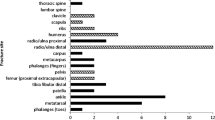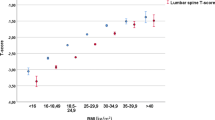Abstract
Summary
Differences in the relationship between femur neck bone mineral density (FNBMD) and fracture risk were examined by age, sex, and race/ethnicity in the third National Health and Nutrition Examination Survey (NHANES III) cohort. FNBMD had similar, significant predictive utility for fracture in the different subgroups, but it did not completely account for subgroup differences in risk.
Purpose
Few previous studies of FNBMD and fracture risk examined the relationship by age, sex, and race within the same cohort. The present study examined the relationship between FNBMD and risk of incident major osteoporotic fracture (hip, spine, radius, and humerus) in older US adults from NHANES III (1988–1994).
Methods
Incident fractures were identified using linked mortality and Medicare records obtained through 2007 for 2,743 men and women ages 65 years and older. FNBMD was measured by dual-energy X-ray absorptiometry. Cox proportional hazards models were used to estimate the hazards ratio (HR) of fracture for FNBMD and femur neck T score and risk of major osteoporotic fracture.
Results
The sample included 380 incident major osteoporotic fractures. Fracture risk approximately doubled for each SD decrease in FNBMD. HR’s for FNBMD were similar within age, sex, or race/Hispanic origin subgroups, and also for T scores calculated with either white female or sex- and race/ethnic-specific reference data. Adding FNBMD to Cox models slightly attenuated HR for age, sex, or race/Hispanic origin, but all three variables remained significant predictors of fracture risk.
Conclusions
FNBMD had similar, significant predictive utility within age, sex, and race/Hispanic origin subgroups. However, FNBMD did not appear to completely account for fracture risk differences in these subgroups. Similarity of HR’s for T scores calculated with two different reference databases support use of a uniform reference database to calculate these scores.

Similar content being viewed by others
Notes
1 SD = 0.14 gm/cm2
References
Nevitt MC, Johnell O, Black DM, Ensrud K, Genant HK, Cummings SR (1994) Bone-mineral density predicts non-spine fractures in very elderly women. Osteoporos Int 4:325–331
Schott AM, Cormier C, Hans D et al (1998) How hip and whole-body bone mineral density predict hip fracture in elderly women: the EPIDOS prospective study. Osteoporos Int 8:247–254
Fujiwara S, Kasagi F, Masunari N, Naito K, Suzuki G, Fukunaga M (2003) Fracture prediction from bone mineral density in Japanese men and women. J Bone Miner Res 18:1547–1553
Schuit SCE, van der Klift M, Weel AEAM, de Laet CEDH, Burger H, Seeman E, Hofman A, Uitterlinden AG, van Leeuwen JPTM, Pols HAP (2004) Fracture incidence and association with bone mineral density in elderly men and women: the Rotterdam Study. Bone 34:195–202
Nguyen ND, Pongchaiyakul C, Center JR, Eisman JA, Nguyen TV (2005) Identification of high-risk individuals for hip fracture: a 14-year prospective study. J Bone Miner Res 20:1921–1928
Cauley JA, Lui LY, Ensrud KE, Zmuda JM, Stone KL, Hochberg MC, Cummings SR (2005) Bone mineral density and the risk of incident nonspinal fractures in black and white women. Jama-J Am Med Assoc 293:2102–2108
Barrett-Connor E, Siris ES, Wehren LE, Miller PD, Abbott TA, Berger ML, Santora AC, Sherwood LM (2005) Osteoporosis and fracture risk in women of different ethnic groups. J Bone Miner Res 20:185–194
Johnell O, Kanis JA, Oden A et al (2005) Predictive value of BMD for hip and other fractures. J Bone Miner Res 20:1185–1194
Siris ES, Brenneman SK, Barrett-Connor E, Miller PD, Sajjan S, Berger ML, Chen YT (2006) The effect of age and bone mineral density on the absolute, excess, and relative risk of fracture in postmenopausal women aged 50–99: results from the National Osteoporosis Risk Assessment (NORA). Osteoporos Int 17:565–574
Cummings SR, Cawthon PM, Ensrud KE, Cauley JA, Fink HA, Orwoll ES, Grp MR (2006) BMD and risk of hip and nonvertebral fractures in older men: a prospective study and comparison with older women. J Bone Miner Res 21:1550–1556
Rivadeneira F, Zillikens MC, De Laet CE, Hofman A, Uitterlinden AG, Beck TJ, Pols HAP (2007) Femoral neck BMD is a strong predictor of hip fracture susceptibility in elderly men and women because it detects cortical bone instability: the Rotterdam study. J Bone Miner Res 22:1781–1790
Cauley JA, Wu LL, Wampler NS, Barnhart JM, Allison M, Chen Z, Jackson R, Robbins J (2007) Clinical risk factors for fractures in multi-ethnic women: the women’s health initiative. J Bone Miner Res 22:1816–1826
Mackey DC, Eby JG, Harris F, Taaffe DR, Cauley JA, Tylavsky FA, Harris TB, Lang TF, Cummings SR (2007) Prediction of clinical non-spine fractures in older black and white men and women with volumetric BMD of the spine and areal BMD of the hip: the health, aging, and body composition study. J Bone Miner Res 22:1862–1868
Langsetmo L, Leslie WD, Zhou W et al (2010) Using the same bone density reference database for men and women provides a simpler estimation of fracture risk. J Bone Miner Res 25:2108–2114
Cauley JA, Palermo L, Voot M, Ensrud KE, Ewing S, Hochberg M, Nevitt MC, Black DM (2008) Prevalent vertebral fractures in black women and white women. J Bone Miner Res 23:1458–1467
Kanis JA, WHO Scientific Group on Assessment of Osteoporosis at the Primary Health-care Level (2007) Assessment of osteoporosis at the primary health-care level. World Health Organization, Geneva
Centers for Disease Control and Prevention National Center for Health Statistics (1994) Plan and Operation of the Third National Health and Nutrition Examination Survey, 1988–94. In: Department of Health and Human Services (ed) Series 1: Programs and collection procedures. Centers for Disease Control and Prevention, National Center for Health Statistics, Hyattsville, pp 1–407
Centers for Disease Control and Prevention National Center for Health Statistics (2012) NHANES Questionnaires, datasets and related documentation. Centers for Disease Control and Prevention, National Center for Health Statistics. http://www.cdc.nchs.gov/nchs/nhanes/nhanes_questionnaires.htm. Accessed 19 May 2013
Centers for Disease Control and Prevention National Center for Health Statistics (2012) NCHS data linked to mortality files. Centers for Disease Control and Prevention, National Center for Health Statistics. http://www.cdc.gov/nchs/data_access/data_linkage/mortality.htm. Accessed 19 May 2013
Centers for Disease Control and Prevention National Center for Health Statistics (2012) NCHS Data linked to CMS Medicare enrollment and claims files. Centers for Disease Control and Prevention, National Center for Health Statistics. http://www.cdc.gov/nchs/data_access/data_linkage/CMS_Medicare.htm. Accessed 19 May 2013
Moon M (1996) What Medicare has meant to older Americans. Health Care Financ R 18:49–59
Ray WA, Griffin MR, Fought RL, Adams ML (1992) Identification of fractures from computerized Medicare files. J Clin Epidemiol 45:703–714
Taylor AJ, Gary LC, Arora T et al (2011) Clinical and demographic factors associated with fractures among older Americans. Osteoporos Int 22:1263–1274
Curtis JR, Mudano AS, Solomon DH, Xi J, Melton E, Saag KG (2009) Identification and validation of vertebral compression fractures using administrative claims data. Med Care 47:69–72
Association AM (2010) CPT (Current Procedural Terminology) Assistant Archives 1990–2009. American Medical Association, Chicago IL
National Center for Health Statistics (2010) Conversion Table of New ICD-9-CM Codes. National Center for Health Statistics, http://www.cdc.gov/nchs/data/icd9/icdcnvFY11.pdf. Accessed 19 May 2013
Baron JA BJ, Berger M, NCCDPHP (1996) Incidence and cost to Medicare of fractures among Medicare beneficiaries aged ≥65 years: United States July 1991–June 1992. MMWR 45:877–883
Wahner HW, Looker A, Dunn WL, Walters LC, Hauser MF, Novak C (1994) Quality control of bone densitometry in a national health survey (NHANES III) using three mobile examination centers. J Bone Miner Res 9:951–960
Kanis JA, McCloskey EV, Johansson H, Oden A, Melton LJ 3rd, Khaltaev N (2008) A reference standard for the description of osteoporosis. Bone 42:467–475
Research Triangle Institute (2008) SUDAAN Language Manual, Release 10.0. Research Triangle Institute, Research Triangle Park, NC
Walters SJ (2001) What is a Cox model? Hayward Medical Communications, p 8
Looker AC, Wahner HW, Dunn WL, Calvo MS, Harris TB, Heyse SP, Johnston CC Jr, Lindsay R (1998) Updated data on proximal femur bone mineral levels of US adults. Osteoporos Int 8:468–489
National Center for Health Statistics Office of Analysis and Epidemiology (2011) Use of survey weights for linked data—preliminary guidance. National Center for Health Statistics, Hyattsville
Baim S, Binkley N, Bilezikian JR, Kendler DL, Hans DB, Lewiecki EM, Silverman S (2008) Official positions of the International Society for Clinical Densitometry and executive summary of the 2007 ISCD Position Development Conference. J Clin Densitom 11:75–91
Looker AC, Sempos CT, Liu KA, Johnson CL, Gunter EW (1990) Within-person variance in biochemical indicators of iron status: effects on prevalence estimates. Am J Clin Nutr 52:541–547
Kanis JA, Johnell O, Oden A, Borgstrom F, Zethraeus N, De Laet C, Jonsson B (2004) The risk and burden of vertebral fractures in Sweden. Osteoporos Int 15:20–26
Stone KL, Seeley DG, Lui LY, Cauley JA, Ensrud K, Browner W, Nevitt MC, Cummings SR, Osteoporotic Fractures R (2003) BMD at multiple sites and risk of fracture of multiple types: long-term results from the study of osteoporotic fractures. J Bone Miner Res 18:1947–1954
Looker AC (2013) Serum 25-hydroxyvitamin D and risk of major osteoporotic fracture in older US adults. J Bone Miner Res 28;997–1006
Conflicts of interest
The findings and conclusions in this report are those of the authors and do not necessarily represent the views of the Centers for Disease Control and Prevention.
Author information
Authors and Affiliations
Corresponding author
Electronic supplementary material
Below is the link to the electronic supplementary material.
ESM 1
(DOCX 20 kb)
Rights and permissions
About this article
Cite this article
Looker, A.C. Femur neck bone mineral density and fracture risk by age, sex, and race or Hispanic origin in older US adults from NHANES III. Arch Osteoporos 8, 141 (2013). https://doi.org/10.1007/s11657-013-0141-4
Received:
Accepted:
Published:
DOI: https://doi.org/10.1007/s11657-013-0141-4




